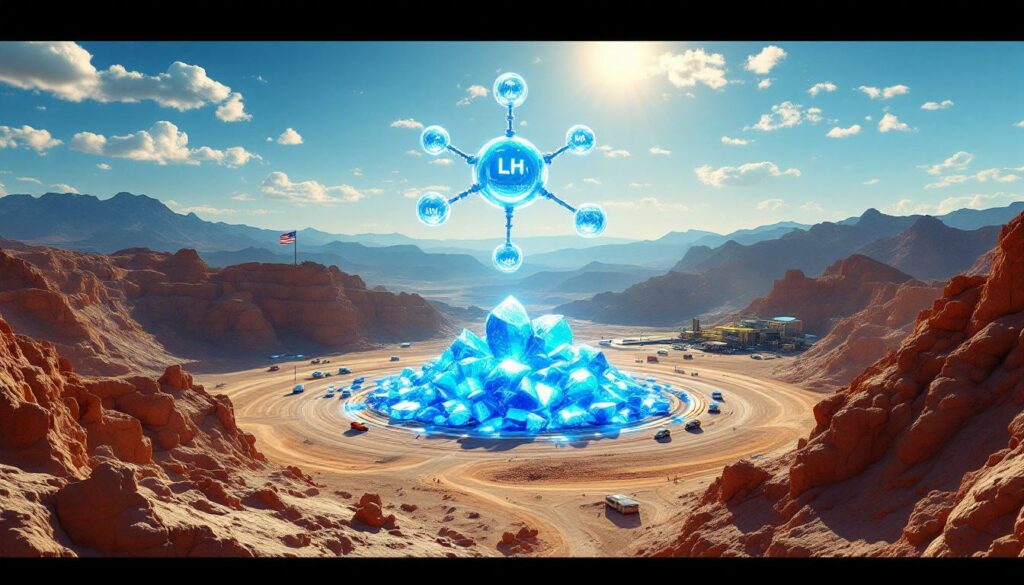What is the Tonopah Flats Lithium Project and Why Does it Matter?
The Tonopah Flats lithium project represents a strategic milestone in America’s push for energy independence and critical mineral security. Located in west-central Nevada on land managed by the US Department of Interior, this project has emerged as a cornerstone of domestic lithium production efforts. Its significance extends beyond simple resource extraction—it symbolizes America’s commitment to securing its technological future.
The Strategic Significance of ABTC’s Tonopah Flats Project
Federal Priority Status and Its Implications
In a landmark decision highlighting the project’s national importance, the US Federal Permitting Council has designated American Battery Technology Company’s (ABTC) Tonopah Flats lithium facility as a transparency priority project. This classification is far from ceremonial—it effectively fast-tracks the federal permitting process through the FAST-41 program, reflecting the project’s critical role in strengthening domestic lithium production capabilities.
Ryan Melsert, CEO of ABTC, emphasized the significance of this designation: “We are excited by this selection of our Tonopah Flats lithium project as a FAST-41 critical mineral transparency project. As we are currently working through permitting efforts with multiple federal agencies for the construction of this domestic critical mineral project, the support to coordinate and fast-track these efforts is greatly appreciated.”
FAST-41 Dashboard Inclusion
The project’s addition to the FAST-41 permitting dashboard represents more than bureaucratic reshuffling—it provides a transparent mechanism for tracking progress through complex regulatory frameworks. This designation helps coordinate and expedite permitting efforts across multiple federal agencies, including the Bureau of Land Management, Environmental Protection Agency, and Department of Energy, streamlining what has traditionally been a complex regulatory process that can delay critical minerals transition for years.
How Does Tonopah Flats Compare to Other US Lithium Resources?
One of America’s Largest Lithium Deposits
According to ABTC’s updated assessment from April 2024, Tonopah Flats ranks as one of the largest identified lithium resources in the United States. This assessment was conducted in compliance with Securities and Exchange Commission (SEC) S-K 1300 guidelines, confirming the project’s significant scale and economic potential.
The deposit’s magnitude represents a game-changer for domestic lithium supply chains, potentially reducing America’s dangerous dependence on foreign sources. Industry analysts note that securing domestic lithium supplies has become increasingly critical as global demand continues to outpace available resources.
Claystone vs. Traditional Lithium Sources
Unlike conventional lithium extraction from hard rock spodumene (as seen in Australia) or lithium-rich brines (common in South America), Tonopah Flats utilizes Nevada’s abundant claystone deposits. This represents an innovative approach to lithium production in a country that lacks large quantities of traditional lithium sources.
Geological Context: Nevada’s lithium-rich claystones were formed millions of years ago in ancient lake beds. These unique formations contain lithium adsorbed to clay particles rather than in brine solutions or crystalline structures, requiring specialized extraction technologies.
The claystone approach offers several advantages over traditional sources, including reduced water consumption compared to brine operations and potentially lower environmental impact than hard rock mining when utilizing ABTC’s proprietary technologies.
What Technological Innovations Make This Project Unique?
ABTC’s Proprietary Extraction Methods
Low-Impact Processing Technology
ABTC has developed specialized low-cost, environmentally responsible technologies specifically designed to extract lithium from Nevada’s claystone materials. These innovations aim to minimize environmental impact while maximizing resource utilization.
The company’s approach differs significantly from traditional acid leaching methods used in other claystone operations. While specific details remain proprietary, the process is designed to reduce water consumption, minimize waste generation, and lower the carbon footprint compared to conventional extraction methods.
Proven Production Capabilities
The company has already demonstrated its ability to produce battery-grade lithium hydroxide from claystone at its pilot plant facility. This successful proof-of-concept serves as the foundation for scaling up to commercial production.
The pilot operations have validated several key technical parameters:
- Successful extraction of lithium from claystone matrices
- Purification to battery-grade specifications (99.5%+ purity)
- Conversion to lithium hydroxide, the preferred form for high-performance EV batteries
- Process optimization for commercial scalability
Commercial-Scale Development Plans
Partnership with Black & Veatch
ABTC has partnered with engineering firm Black & Veatch to develop a commercial-scale refinery with an ambitious production target of 30,000 tonnes of lithium hydroxide annually. This collaboration brings together ABTC’s innovative extraction technology with Black & Veatch’s expertise in designing and building large-scale processing facilities.
The partnership represents a significant step toward commercialization, leveraging Black & Veatch’s extensive experience in developing industrial facilities that meet stringent environmental and operational standards.
Integrated Mine and Refinery Approach
The project uniquely combines both mining and refining operations at a single site, potentially reducing transportation costs and environmental impacts while streamlining the production process. This integrated approach differs from many lithium operations worldwide, where raw materials are often shipped thousands of miles for processing.
By co-locating extraction and refining operations, ABTC aims to:
- Minimize logistics costs and carbon emissions from transportation
- Reduce handling and processing losses
- Enhance quality control throughout the production chain
- Streamline permitting and operational management
How is the Tonopah Flats Project Being Funded?
Government Support and Investment
Department of Energy Grant
The project has secured a $58 million grant from the US Department of Energy designated for its initial construction phase, demonstrating federal commitment to domestic lithium production. This funding comes as part of broader government initiatives to secure critical mineral supply chains.
The DOE grant provides essential capital for initial development while validating the project’s technological approach and strategic importance. Such federal backing often serves as a catalyst for attracting additional private investment, creating a multiplier effect on available funding.
Export-Import Bank Financing
In a significant financial development, ABTC has received a letter of interest from the Export-Import Bank of the United States for $900 million in financing. This potential funding aims to support the expansion of the commercial-scale lithium mine and refinery operations.
It’s important to note that a letter of interest represents a preliminary step in the financing process, not a final commitment. However, the scale of potential financing underscores the project’s alignment with national strategic priorities. If approved, this funding would accelerate development timelines and potentially increase production capacity.
Alignment with National Strategic Initiatives
Make More in America Initiative
The project aligns perfectly with the Make More in America initiative, which seeks to strengthen domestic manufacturing capabilities in critical sectors. This strategic alignment has helped secure both financial support and regulatory prioritization.
By producing lithium domestically, the project supports broader goals of reshoring critical industries and reducing vulnerability to international supply chain disruptions. The economic benefits extend beyond the project itself to support domestic battery manufacturing and electric vehicle production.
China and Transformational Export Program
ABTC’s development efforts support the China and Transformational Export Program, reflecting strategic efforts to counter competition from China and ensure US leadership in critical mineral manufacturing. This program specifically targets industries where Chinese dominance threatens America’s economic and national security.
The global lithium market has historically been dominated by a small number of countries, with China controlling significant portions of the processing capacity. Projects like Tonopah Flats represent America’s strategic response to this concentration of critical resources.
What Impact Will This Project Have on US Lithium Supply?
Domestic Supply Chain Strengthening
Reducing Import Dependence
The Tonopah Flats lithium project aims to significantly reduce America’s reliance on imported lithium, a critical component in technologies ranging from energy storage to defense systems and electric vehicles. Currently, the US imports approximately 95% of its lithium needs, creating substantial strategic vulnerability.
When fully operational, the project’s 30,000 tonnes of annual lithium hydroxide production would represent a substantial portion of domestic demand, potentially reducing import requirements by 15-20% based on projected 2026 consumption rates.
Supporting the EV Revolution
With electric vehicle adoption accelerating, domestic lithium production becomes increasingly vital for US automotive manufacturers and battery producers. Major automakers have announced ambitious electrification targets, with some planning to phase out internal combustion engines entirely by 2035.
This transition creates enormous demand for battery materials:
- A typical electric vehicle requires 8-10 kg of lithium
- Projected US EV sales could require over 200,000 tonnes of lithium annually by 2030
- Domestic production reduces supply chain risks for US manufacturers
Regulatory and Policy Support
Executive Order Alignment
The project benefits from Trump executive order of March 20, 2025, which mandates federal agencies to streamline permitting processes and facilitate funding and offtake agreements for critical mineral production. This executive action specifically targets bureaucratic barriers that have historically delayed domestic mining projects.
The order directs federal agencies to:
- Prioritize permitting for critical mineral projects
- Reduce redundant environmental reviews
- Facilitate public-private partnerships for resource development
- Support financing mechanisms for domestic production
Strategic Resource Development
By developing domestic lithium resources, the US aims to secure its position in the global battery supply chain while reducing vulnerability to international supply disruptions. This strategy recognizes lithium as essential to both economic competitiveness and national security.
The development of Tonopah Flats contributes to a broader portfolio of domestic lithium projects, including Thacker Pass lithium mine (also in Nevada) and operations in North Carolina. Together, these projects could substantially reduce America’s dangerous dependence on foreign sources.
What Challenges and Opportunities Lie Ahead?
Scaling Production Capabilities
From Pilot to Commercial Scale
While ABTC has demonstrated production capabilities at the pilot level, scaling to commercial production presents significant engineering and operational challenges. The transition from laboratory or pilot-scale operations to full commercial production involves numerous technical hurdles:
- Process consistency across larger volumes
- Equipment reliability and maintenance requirements
- Quality control at commercial scale
- Workforce training and operational procedures
- Supply chain management for reagents and consumables
Industry experts note that novel extraction technologies often encounter unexpected challenges during scale-up, requiring iterative problem-solving and potential process modifications.
Technology Optimization
Continued refinement of extraction and processing technologies will be crucial for maximizing efficiency and minimizing environmental impact. As the project moves toward commercial operation, several areas require ongoing optimization:
- Reagent consumption and recycling
- Energy efficiency throughout the process
- Water management and conservation
- Waste minimization and management
- Recovery rates and product purity
The company’s ability to continuously improve these parameters will directly impact both economic performance and environmental footprint.
Market and Economic Considerations
Global Lithium Price Fluctuations
The economic viability of the project will depend partly on global lithium prices, which have shown significant volatility in recent years. After peaking at over $80,000 per tonne in late 2022, lithium prices experienced a dramatic correction, falling below $20,000 per tonne in early 2024.
This volatility creates both challenges and opportunities:
- Price uncertainty complicates investment decisions
- Lower prices may pressure operational margins
- Higher prices improve project economics but risk demand destruction
- Price stability is ultimately needed for sustainable industry growth
Price Volatility Context: Lithium markets have historically experienced boom-bust cycles. The most recent price collapse occurred as Chinese EV demand temporarily slowed while new production capacity came online. Long-term forecasts generally predict strong demand growth, but timing supply additions remains challenging.
Competition from International Producers
Despite domestic advantages, the project will still face competition from established international lithium producers with potentially lower production costs. Major global producers enjoy several competitive advantages:
- Australian hard rock operations benefit from existing infrastructure and economies of scale
- South American brine operations typically have lower operating costs
- Chinese processors control significant portions of the refining capacity
- Established producers often have long-term supply agreements with major customers
To compete effectively, ABTC must leverage its technological innovations, proximity to US markets, and government support to offset these advantages.
FAQs About the Tonopah Flats Lithium Project
What makes the Tonopah Flats project different from other lithium operations?
Unlike most lithium operations that rely on brine evaporation or hard rock mining, Tonopah Flats utilizes innovative technologies to extract lithium from claystone deposits, representing a new approach to lithium production in the United States. This technological differentiation allows for resource development in regions previously not considered viable for lithium production.
The claystone approach also offers potential environmental advantages, including reduced water consumption compared to brine operations in water-stressed regions like Chile’s Atacama Desert.
How does the FAST-41 designation benefit the project?
The FAST-41 designation helps coordinate permitting efforts across multiple federal agencies, potentially reducing approval timelines and providing greater transparency throughout the regulatory process. This coordination is particularly valuable for complex projects requiring approvals from numerous agencies.
Benefits include:
- A single timeline incorporating all federal environmental reviews and authorizations
- Transparent tracking of progress via the FAST-41 dashboard
- Enhanced interagency coordination to reduce delays
- Potential resolution of interagency conflicts through established mechanisms
What is the projected annual production capacity?
The commercial-scale refinery aims to produce approximately 30,000 tonnes of lithium hydroxide annually when fully operational. This production capacity would represent a significant addition to domestic supply and could support battery production for hundreds of thousands of electric vehicles annually.
The facility design incorporates potential expansion capabilities, allowing production to scale with market demand if economic conditions warrant.
How does this project support US energy independence?
By developing domestic lithium resources, the project reduces reliance on imported materials critical for energy storage technologies, supporting greater energy security and independence. This domestic production creates multiple strategic benefits:
- Reduced vulnerability to international supply disruptions
- Shorter supply chains with lower transportation emissions
- Creation of high-skilled domestic jobs in mining and processing
- Support for domestic battery manufacturing and electric vehicle production
What environmental considerations are being addressed?
ABTC has developed low-impact technologies specifically designed to minimize environmental footprint while extracting lithium from claystone materials. The company’s approach includes several sustainability elements:
- Reduced water consumption compared to traditional lithium extraction
- Minimized land disturbance through efficient site design
- Waste reduction and potential for beneficial reuse of byproducts
- Energy efficiency measures throughout the process
The project must also comply with rigorous environmental permitting requirements, including detailed assessment and mitigation of potential impacts to air, water, wildlife, and cultural resources.
Furthermore, ABTC is exploring SLE techniques that could further improve the environmental profile of its operations while enhancing recovery rates and process efficiency.
The company’s commitment to sustainable mining industry innovation positions Tonopah Flats as a potential model for 21st-century resource development that balances economic objectives with environmental stewardship.
Disclaimer: This article contains forward-looking statements regarding project development, production targets, and market conditions. Actual results may differ materially from projections due to various factors including technological challenges, regulatory delays, market conditions, and other risks. Readers should not make investment decisions based solely on this information.
Worried About Missing Out on the Next Major Mineral Discovery?
Discover why significant mineral discoveries can lead to exceptional market returns by exploring Discovery Alert’s dedicated discoveries page, where our proprietary Discovery IQ model delivers real-time alerts on ASX mineral discoveries, transforming complex data into actionable investment opportunities. Begin your 30-day free trial today at Discovery Alert to position yourself ahead of the market.




